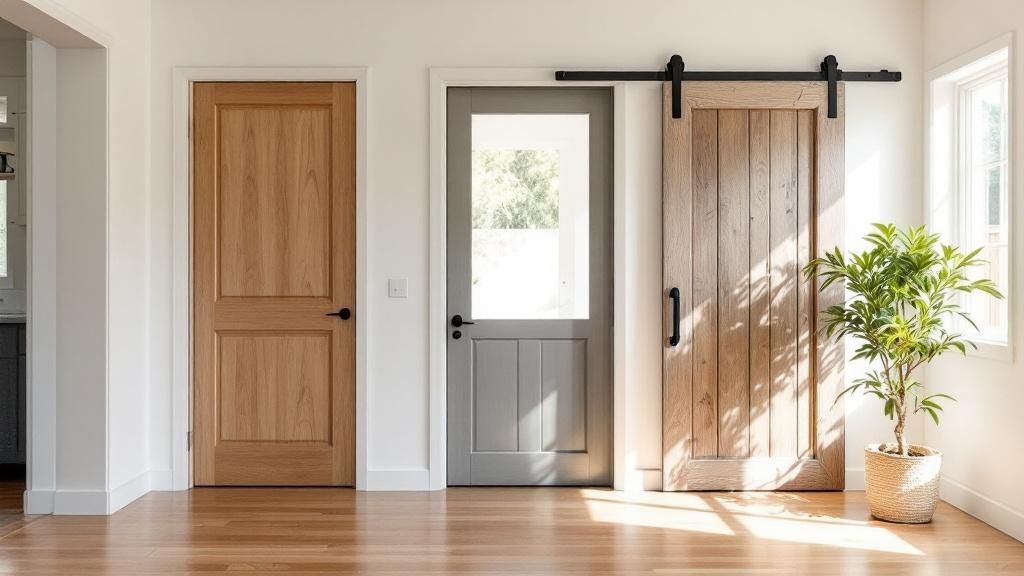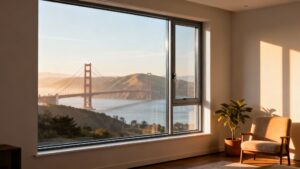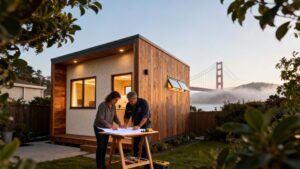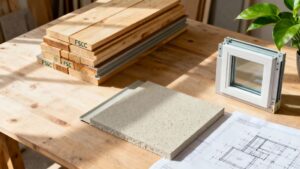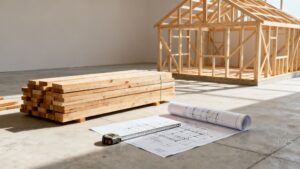Choosing the right interior door is about more than just closing off a room; it’s a key decision that defines your home's character and functionality. For builders, contractors, and homeowners in Berkeley, Oakland, and across the Bay Area, the process boils down to three key elements: the door's material, its architectural style, and its day-to-day function.
A heavy, solid-core door is perfect for a home office where quiet is essential. But for a simple linen closet, a practical, lightweight hollow-core door often makes the most sense. This guide will help you navigate the choices to find the perfect fit for your project.
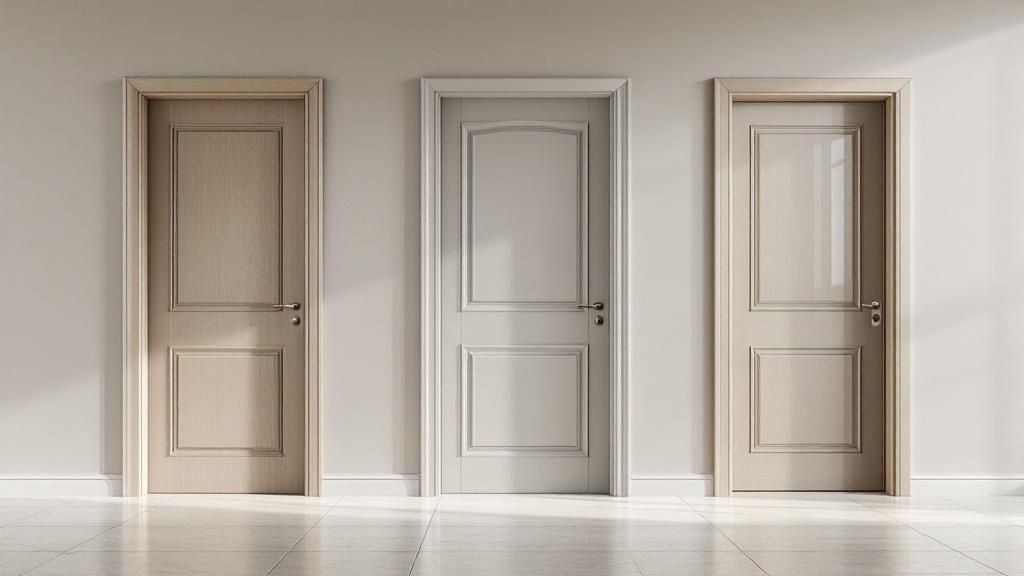
Why Choosing the Right Interior Door Matters
Interior doors are true workhorses, integral to a home's character and influencing everything from noise levels to the visual flow of your space. What works for a classic Berkeley bungalow might not be the right fit for a sleek, modern San Francisco condo. Making the right choice means balancing aesthetics, performance, and budget.
This is a significant detail in any build or remodel. The global interior doors market reached approximately USD 55.59 billion in 2022, according to Allied Market Research, driven by new construction and renovations. Unlike exterior doors built for security, interior doors are the elegant partitions that shape how it feels to live inside a home.
Quick-Start Guide: Key Questions to Ask First
To get your project started on the right foot, this quick-start guide helps you think through the most important initial questions.
| Consideration | Key Questions to Ask | Top Choices for Bay Area Homes |
|---|---|---|
| Function & Location | Is this for a bedroom needing privacy, a pantry needing ventilation, or a high-traffic hallway? How much sound-dampening is required? | Solid-core for bedrooms/offices. Louvered or glass-panel for closets/pantries. Hollow-core for low-traffic areas. |
| Architectural Style | Does the door need to match a historic Craftsman, a mid-century Eichler, or a contemporary new build? What style is the existing trim and casing? | Shaker-style doors for versatility. Flat-panel for modern homes. Raised-panel for traditional or Victorian styles. |
| Project Scope | Are you replacing a single damaged door slab, or are you outfitting an entire home with pre-hung units? | For single replacements, a slab might work. For new builds or major remodels, pre-hung doors save significant labor. |
Answering these questions provides a solid framework for making smart, confident decisions as you move forward. To explore the quality and variety available from leading manufacturers, see the featured door brands at Truitt & White.
Now, let's dive into the specifics, starting with the most fundamental choice: the material.
Decoding Door Materials for Bay Area Homes
The material of an interior door dictates its weight, sound-blocking ability, and durability. For contractors and homeowners here in the Bay Area, this choice is a balancing act between aesthetics and practical needs, considering our unique climate and architectural diversity from Oakland to San Francisco.
Before selecting materials, however, you must get your measurements right. A perfect fit is non-negotiable, and taking accurate measurements of your doorway's width and height is the single best way to avoid costly mistakes.
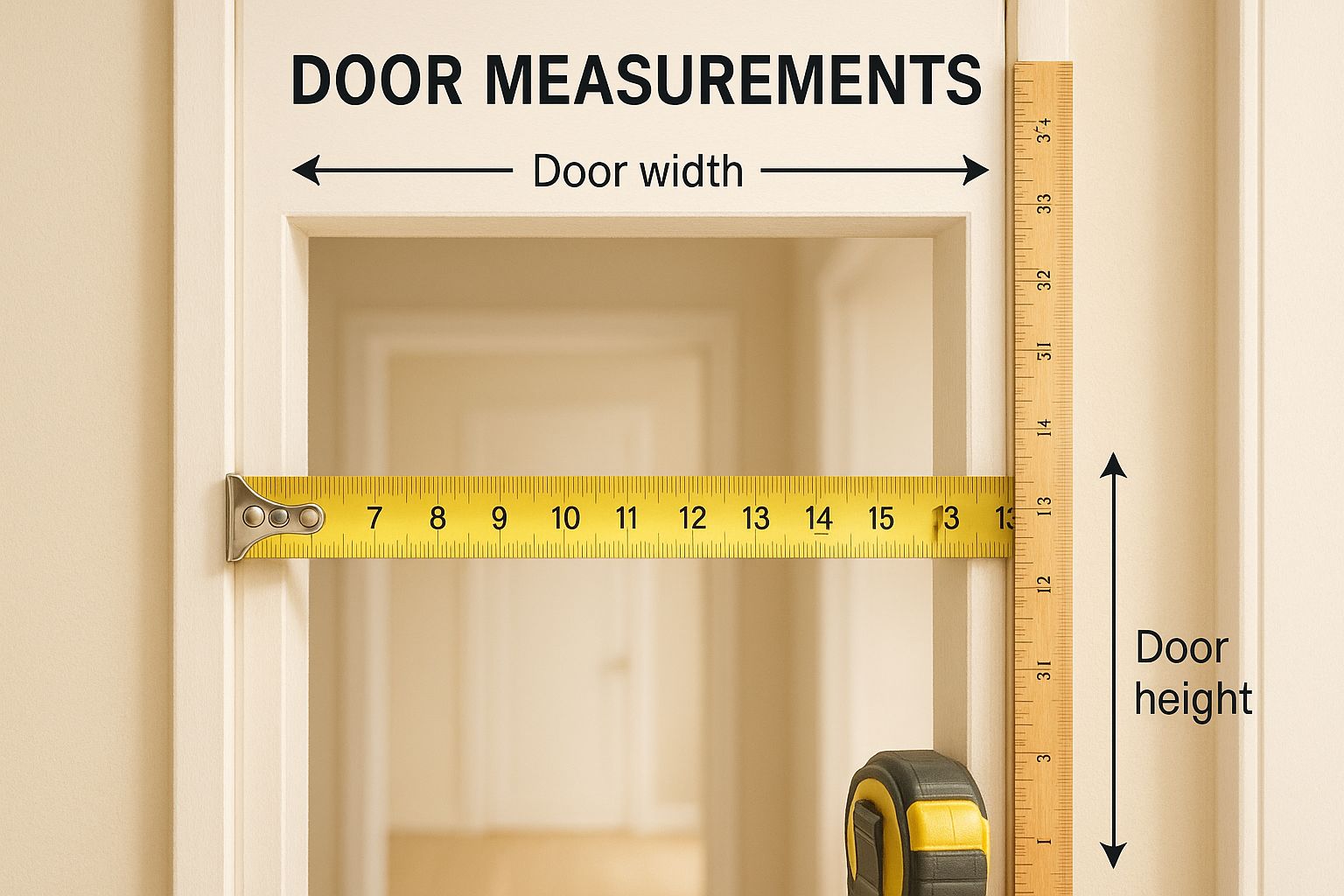
Comparing Common Interior Door Materials
Choosing the right material comes down to the specific needs of each room. A door for a home office has different requirements than one for a closet. This table lays out the pros and cons of common options.
| Material | Average Cost | Durability | Sound Insulation | Best For |
|---|---|---|---|---|
| Solid Wood | High | High | Excellent | Bedrooms, home offices, and anywhere acoustic privacy is key. |
| Solid-Core | Moderate | High | Good | High-traffic areas, hallways, and primary rooms. |
| Hollow-Core | Low | Low | Poor | Closets, pantries, and low-traffic areas where budget is primary. |
| MDF/Composite | Low-Moderate | Moderate | Fair | Rooms needing a custom, smooth paint finish. |
There's a clear trade-off between cost, durability, and performance. Thinking about how you use each space will point you toward the best material.
Solid Wood Doors
Solid wood doors offer a timeless beauty and a substantial, high-quality feel. Crafted from a single type of wood—like oak, pine, or mahogany—they bring natural warmth to a space and are fantastic for dampening sound. This makes them a perfect choice for bedrooms or a home office.
In foggy Bay Area neighborhoods, a solid wood door must be sealed properly on all six sides before installation to prevent warping or swelling from humidity.
Solid-Core Doors
Solid-core doors are a popular middle-ground, offering much of the heft and sound insulation of solid wood at a more approachable price. A core of composite wood (like particleboard) is sandwiched between a wood veneer or a smooth, paintable surface.
This construction makes them incredibly stable and less prone to humidity issues than solid wood. They are a reliable and durable option for almost any room, especially busy hallways or kids' rooms.
Pro Tip: Bay Area builders often use solid-core doors for main rooms and matching hollow-core doors for closets. It’s a smart way to get a consistent look and feel throughout the home while managing the budget.
Hollow-Core Doors
When budget is the primary concern, hollow-core doors are the go-to. They are lightweight, consisting of a wood frame filled with honeycomb cardboard and covered with a thin skin of wood veneer or fiberboard. Their light weight makes them easy to handle and install.
The trade-off is significant, as they offer almost no sound insulation. We recommend hollow-core doors only for places where acoustic privacy is a non-issue, like closets, pantries, or utility rooms.
Molded Composite and MDF Doors
Molded composite doors, especially those made from Medium-Density Fiberboard (MDF), are prized for their perfectly smooth surface that takes paint beautifully. If you're looking for a flawless, custom-colored finish, MDF is an excellent choice.
These doors are also quite stable and resistant to warping, making them a solid pick for most interior applications. While they offer better sound dampening than hollow-core doors, they don't match solid-core or solid wood. For a deeper dive, check out our guide on considerations when choosing windows and doors.
Matching Door Styles to Your Home's Architecture
An interior door is a critical piece of your home's architectural story. The right style can either blend in seamlessly or stand out as a focal point, elevating everything from a historic Victorian in Oakland to a minimalist modern build in Berkeley.
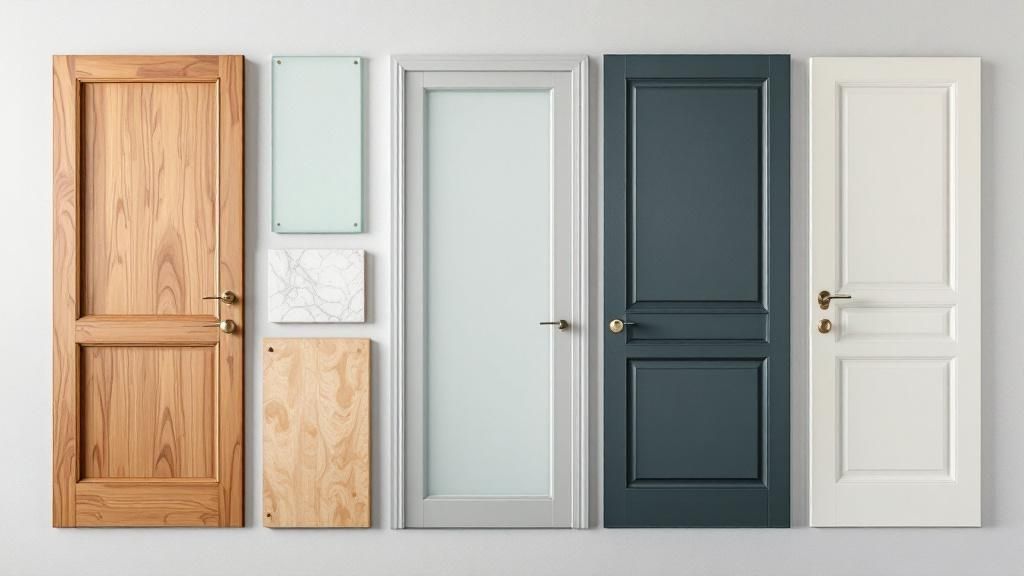
Think of your doors as part of the home's DNA, speaking the same design language as your window casings, baseboards, and cabinetry. This harmonious flow adds real, tangible value to the property.
Popular Panel and Flush Door Styles
Panel and flush doors are the two main players, offering incredible versatility for any architectural period.
- Shaker Style Doors: With clean lines and a simple, flat-panel design, Shaker doors are a workhorse in modern design. Their unadorned look is a perfect fit for contemporary, transitional, and updated Craftsman homes across the Bay Area.
- Flush Doors: Featuring a completely flat, smooth surface, flush doors lend a minimalist aesthetic to contemporary homes and provide a clean canvas for a bold paint color.
- Multi-Panel Doors: These classic doors use raised or recessed panels to create depth. A six-panel door is a hallmark of Colonial or Victorian homes, while a two or three-panel design often feels more transitional.
Functional Styles for Space and Character
Beyond standard hinged doors, some styles solve specific problems, like tight floor plans or the need for better airflow.
- Pocket Doors: These space-savers slide into a pocket inside the wall, disappearing when open. They are an elegant solution for tight spots like bathrooms or home offices in smaller San Francisco apartments.
- Barn Doors: A favorite for rustic, farmhouse, or industrial looks, barn doors slide along an external track. They make a strong visual statement and are brilliant for dividing larger spaces without fully closing them off.
- French Doors: Defined by glass panes, French doors bring elegance and let natural light flow between rooms. They're ideal for a grand entrance to a home office or dining room. For a look at exceptional craftsmanship, check out our door spotlight on Simpson Door Company.
- Louvered Doors: With horizontal slats, louvered doors provide air circulation, making them a go-to choice for closets, pantries, and laundry rooms to prevent mustiness.
Nailing the Details: Operation, Fit, and Hardware
A beautiful door is worthless if it doesn't function correctly. Before getting attached to a style, you must nail down the mechanics. How it opens, where it fits, and how it will function are critical details for contractors in the Bay Area who need to get it right the first time.
This starts with precise measurements of the rough opening or the old door you're replacing. This step is non-negotiable to prevent headaches and project delays, especially in older Berkeley or San Francisco homes known for non-standard frames.
Pre-Hung Doors vs. Slab Doors
One of the first practical decisions is choosing between a pre-hung unit and a slab door, depending on your project scope.
- Pre-Hung Doors: This is a complete, ready-to-install kit that includes the door, hinges, and frame. Pre-hung units are the standard for new construction or major remodels, saving labor and guaranteeing a perfect fit.
- Slab Doors: A slab is just the door itself, without a frame or hinges. This is ideal when you're swapping out an old door but the existing frame is in good condition.
Understanding Door Swing (Handing)
The direction a door opens can make or break a room's flow. A door should always swing into the room it serves, ideally opening against a blank wall to keep from blocking a hallway.
To determine the swing (also called "handing"), stand in the hallway facing the doorway:
- If the door opens away from you (pushing it into the room), it's an inswing.
- If the hinges are on the left, it's a left-hand door.
- If the hinges are on the right, it's a right-hand door.
Combine these to get your final spec (e.g., "left-hand inswing"). This is the exact terminology needed when ordering from a supplier like Truitt & White.
Choosing Hardware and Finishes
Door hardware is the jewelry that completes the outfit. The right knobs, levers, and hinges unify your design by tying into other finishes.
- Matte Black: Bold and modern, it creates a stunning contrast against light-colored doors.
- Satin Nickel & Chrome: These versatile finishes are workhorses. Satin nickel resists fingerprints, while chrome offers a brighter, modern look.
- Aged Bronze & Brass: These warmer finishes are a perfect match for traditional or historic homes, like a classic Victorian in San Francisco.
For a cohesive look, stick with the same hardware finish on a single floor. For a detailed breakdown, see our guide on how to choose the correct door hardware for your home.
Budgeting and Sourcing Doors in the Bay Area
A thoughtful budget is the bedrock of a successful interior door project. This means looking beyond the sticker price to account for materials, hardware, and professional installation. Investing in quality pays back for years in durability and satisfaction.
Understanding the Costs
The final cost will hinge on a few key factors:
- Hollow-Core Doors: Your most budget-friendly option, smart for closets and pantries.
- Solid-Core & MDF Doors: The mid-range workhorse, offering a substantial feel and sound dampening for bedrooms and offices.
- Solid Wood Doors: The premium pick with the highest price tag, delivering unmatched natural beauty and acoustic performance.
Budgeting Insight: Savvy Bay Area contractors often mix and match materials. They install premium solid-core doors in high-traffic spots and use identical hollow-core doors for closets to maintain a consistent look while managing the budget.
Sourcing Your Materials Locally
Partnering with a dedicated local building material supplier like Truitt & White provides access to a wider world of quality products and expertise. Visiting a showroom in Berkeley lets you feel the difference between a hollow-core and a solid-core door.
A local supplier is also invaluable for ensuring compliance with building codes and sustainability standards important across Oakland and San Francisco. For tricky renovations in older homes, ask about our custom door shop and milling services to get a perfect fit. If you're managing the project yourself, learning how to be your own general contractor can be empowering.
Frequently Asked Questions About Interior Doors
Here are answers to some of the most common questions we hear from builders, homeowners, and architects in the Bay Area.
What is the main difference between a pre-hung and a slab door?
A pre-hung door is an all-in-one package including the door, hinges, and frame, ready to install. It's ideal for new construction. A slab door is just the door itself, perfect for replacing an old door when the existing frame is in good shape.
When should I choose a solid-core door over a hollow-core one?
Choose a solid-core door for rooms needing quiet and a substantial feel, like bedrooms, bathrooms, and home offices. Use hollow-core doors for budget-sensitive areas where soundproofing is not a concern, such as closets and pantries. Many Bay Area projects mix and match to balance cost and quality.
What is the best door material for a humid bathroom?
Solid-core composite or Medium-Density Fiberboard (MDF) doors are excellent choices as they are stable and resist moisture. If you prefer solid wood, ensure it is sealed on all six sides before installation to prevent warping from the Bay Area's humidity.
How do I ensure my new doors match my home’s architectural style?
Take cues from your home's existing character by looking at window casings, baseboards, and cabinet styles. A simple, clean-lined Shaker-style door is versatile and fits everything from historic Craftsman homes to modern builds across the Bay Area, creating a seamless, professional look.
Are there fire safety door regulations in California I should know about?
Yes. California building codes often require fire-rated doors in specific locations, most commonly for the door connecting an attached garage to the home's interior. According to the California Building Code, this door typically needs at least a 20-minute fire rating to slow a fire's spread. Always confirm current local requirements for your specific Bay Area city.
For hands-on guidance and to explore a wide selection of high-quality doors, the team at Truitt & White is here to help. Visit our Berkeley showroom for expert advice and let's get your project started on the right foot.


